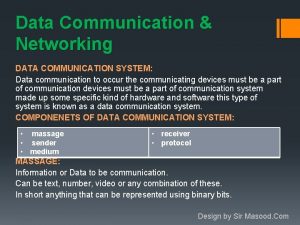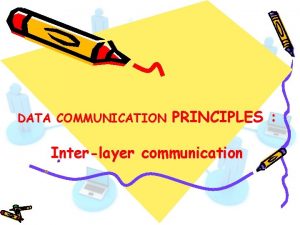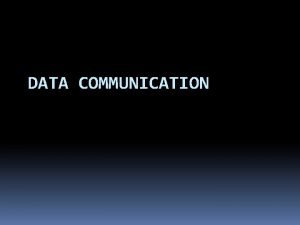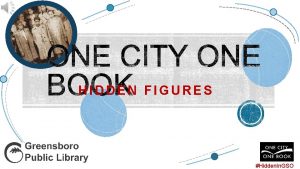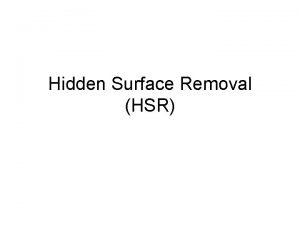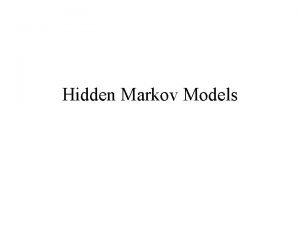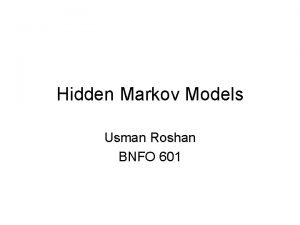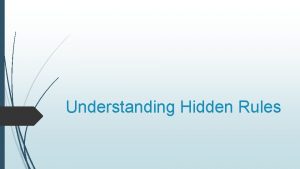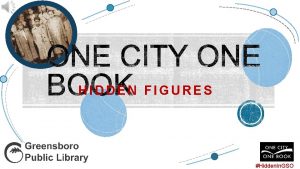THE HIDDEN DATA OF COMMUNICATION Hidden data You













































- Slides: 45

THE HIDDEN DATA OF COMMUNICATION

Hidden data You must all be wondering what is this hidden data which is a part of communication? In fact, it is a very important part of communication. I would go so far as to say that it constitutes nearly 50% of communication. Obtaining this hidden data, and interpreting it correctly, will go a long way in making us effective interpersonally. 2

We shall be considering the following things • • The importance of feelings in communication. How to deal with feelings. The importance of developing assertive skills. The development of self-confidence. 3

Re introduction • Please give your name, and before the name add an adjective starting with the first letter of the name. And then mention what you really like doing in an alliterative form. For example, • Someone can say: I am generous Geeta, and I love giving gifts. 4

Feelings Emotions What is a Siberian Dilemma? 5

IQ Vs EQ IQ EQ Gets you hired Gets you promoted 6

Activity Flight to the moon 7

4 Steps in dealing with feelings Awareness and labeling. Taking action. Reporting your feelings. Feel it now, deal with it later. 8

Come back to haunt us in 3 different ways: 1. The feelings build up inside us, causing stress, which would lead further to psychosomatic diseases. 2. Worse still, these stresses could turn into resentment, and build up to such levels that they come bursting out when we least expect it and don’t want it to. 3. We may unknowingly express the ignored feelings in the form of sarcastic statements, negative body language, or even indirect statements. 9

Activity Let us act • Card 1: SCARED – ANGRY – IMPATIENT • Card 2: HAPPY – CONFUSED – RESTLESS • Card 3: DEPRESSED – PESSIMISTIC – FRUSTRATED • Card 4: ENTHUSIASTIC – FRUSTRATED – OPTIMISTIC • Card 5: REALLY ANGRY – UNDECIDED – BORED 10

Assertiveness Skills Workshop

Do you… • Find it impossible to say “No”? • Agree to do things because it is expected of you? • Go on a holiday/dinner you don’t want because everyone else wants to go there? • Lend money and then feel hesitant to ask for it back? • Eat food you don’t like rather than send it back? • Don’t want to give negative feedback as the person may feel hurt? 12

How should I treat myself? • Stand up for what I want and state my needs clearly. • Choose a behavior consciously and be willing to live with that choice and the consequences. • Value myself and my thoughts. Treat myself and others with equal respect. 13

What is Assertiveness? • Ability to express thoughts, feelings, needs and desires- open, honest, direct and appropriate manner. • Aim to promote communication, solve the problem and get the best result; a win-win solution. • Stands up for his/her tastes, desires, values and opinions while respecting other peoples ideas and opinions, not necessarily agreeing to them. What is Assertiveness? 14

The three skills of Assertiveness: • Expressing yourself with empathy • Looking for areas of agreement • Staying open to different options/choices for mutual gain (winwin) It is a learned skill which enables us to communicate effectively. 15

How does Assertiveness help? Assertiveness helps us to • Increase our self-esteem. • Feel self-confident. • Develop our communication skills. • Gain the respect of others. • Improve our decision-making ability. 16

4 groups to make a presentation on one of the behaviors: a. b. c. d. e. f. State of mind Manifested behavior Respect for self and others Impact on relationship-Long Term and Short Term Active listening skills used Discuss the case study given 17

Assertiveness • To Assert means-to affirm positively, assuredly, plainly and strongly. • Assertiveness is about finding a middle way between aggression and passivity that best respects the personal boundaries of all relationships. • Assertive people defend themselves when someone else attempts to dominate them using their honesty and values to express themselves clearly. 18

Assertive Win-Win The feeling: • Its okay for me to feel the way I do. • I respect you but want you to respect me too. • I can decide to be assertive in appropriate situations • I understand that certain people may not be happy with my decision, and I will accept the incompatibility. 19

TYPES OF BEHAVIOUR ASSERTIVE State of Mind: confident, seeks solutions, Showing Respect: Behavior: Impact: conviction, clarity. respects self and others. reasonable, listens, approachable, negotiates influences. (Short - term) favorable; (Long- term) creates comfort. Active Listening Skills: Good active listening skills. 20

Passive • Passivity, on the other hand is about willingness without desire. • A Passive individual is concerned with being liked and accepted that he/she may never recognize the need to be straightforward. • A Passive person may listen but not accurately because often too anxious to concentrate. The processing gets lost because of the attempt to win acceptance from others 21

Passive Lose-Win The feeling: • • My needs are less important I can’t do anything about it Whatever I say or do will make no difference, so why try? I wonder what they are thinking of me? Perhaps they'll misunderstand my silence • Nobody EVER bothers to find out how I’m feeling • Others do not understand me 22

TYPES OF BEHAVIOUR PASSIVE State of Mind: uncertain, fears confrontation, confused. Showing Respect: Behavior: respects others, but not self. does not say NO, does not say what he means. Impact: (Short - term) favorable; (Long- term) taken for granted. Active Listening Skills: none 23

Aggression • Aggression is about dominance. • Defend their own rights and work to achieve their goals, likely to disregard the rights of others. • Their needs and feelings are more important than others. • Does not listen well to others as the person is too preoccupied with his/her perspectives. Hence tends to get angry and defensive. • Focuses more on his own desires and how to use others to achieve them. 24

Aggressive Win-Lose The feelings: It does not matter what the argument is about, I have to win. I don’t care if others are right or wrong, I only care about what I feel. I don’t want to hear what they have to say for themselves. 25

TYPES OF BEHAVIOUR AGGRESSIVE State of Mind: I’m always right, Showing Respect: Behavior: to always win, insecure. respects self, but not others. dominant, impolite, unfriendly. confrontationist. Impact: (Short - term) OK; Active Listening Skills: (Long- term) negative. does not even listen. 26

Passive -aggressive(manipulative) • • • Flattery Lying Cheating Pretension Pitting one person against the other • Need to be more honest and considerate of themselves and others. • Believe others are trying to exploit them, so its alright to exploit others. 27

TYPES OF BEHAVIOUR PASSIVE- AGGRESSIVE State of Mind: fear, win at any cost, vindictive. Showing Respect: respects self little, others not much. Behavior: Impact: flattery, deceitful, does not mean what he says. (Short - term) may be +ve; (Long- term) negative. Active Listening Skills: pretended active listening skills. 28

Activity to check behaviors Share the chair 29

BEHAVIOUR AND ASSERTIVENESS Assertiveness is NOT a perfect behavior. Our behavior will depend on the situation. This behavior will lead to consequences. Can we live with the consequences? Assertiveness is a very conscious choice: It is your willingness to make choices about your actions, And your willingness to live with the consequences of that behavior. 30

BEHAVIOUR AND ASSERTIVENESS So, it is important to remember that It is not the behavior that determines assertiveness. Assertiveness is the willingness to live with the consequences of that behavior. Important factor differentiating various behavior is the assumption/belief that we have about ourselves. Let us attempt the ‘Cold Soup’ case-study on page 8. 31

ASSERTIVENESS INHIBITORS • CONSEQUENCES. • RELATIONSHIPS. • BELIEFS. • STAKE. • KNOWLEDGE (or LACK OF IT). 32

TOOLS OF ASSERTIVENESS FOGGING • Acknowledging the truth, but refusing to be drawn debate. into a • It is neither outright denial nor outright acceptance. • Use of words like ‘Maybe’, ‘Perhaps’, ‘It may seem like that’, ‘It’s possible it appears to you like that…” etc. • Avoid use of the word ‘BUT. ’ • Fogging is used when there is a lot of emotionality in the atmosphere. Empathy is also used along with fogging to dissipate the emotional energy. • Fogging is used to handle criticism, and disarm the critic. 33

TOOLS OF ASSERTIVENESS Broken Record • Being Persistent • Stick to the point • Remain focused • Calm and relaxed, no anxiety • Neutral emotion

TOOLS OF ASSERTIVENESS NEGATIVE ASSERTION • Allows you to agree to fair criticism. • You can also say something negative about yourself. • You can apologize to the critic sincerely. • Used when affirming or accepting charges made by others NEGATIVE ENQUIRY • Asking questions which could lead to you hearing something negative about yourself. • Invite criticism to find out why someone is angry, critical or displeased. • You find out if the reason is valid. 35

TOOLS OF ASSERTIVENESS SELF - DISCLOSURE • Recognizing and expressing your feelings. • Talking about your feelings; sharing your feelings with others. • It becomes easier for you to be direct. • Used when you are checking why someone said or did something. • “I” statements are used for self-disclosure. 36

TOOLS OF ASSERTIVENESS FREE INFORMATION • Latching on to other information in the conversation, and picking up that information for further use. • Example - “So what did the client say? ” • Used in any situation to get more information. • • • BODY LANGUAGE Comfortable eye contact. Relaxed facial expressions. Relaxed gestures. Respect for personal space. Relaxed posture. Calm voice and speech pattern. 37

WORKABLE COMPROMISE • Knowing all the options available, and going through them oneby-one till a compromise is reached. • Used when both parties are ready to step down a little from their positions, and live with the decision agreed on. 38

Articulation skills

What is articulation? • Expression • Enunciation • Verbalization • Pronunciation • Communication • Speech 40

The 4 commandments of ARTS Articulation is Capacity of thought, and Capability of structure. Articulation is NOT only quality of English. Articulation is NOT only verbal Communication. Articulation is GOOD Communication. 41

Dispelling myths Ernest Rutherford says… “ If you can’t explain in simple, nontechnical terms, then you really don’t understand it”. 42

The impact of articulation A video clip – From the movie “Gandhi ” Observations • The strength of conviction – Awareness of the gains/consequences • The structuring of articulation – Get everybody’s attention – Involve the audience – Transitioning between the audience emotion and Gandhiji’s point of view – Buy-in • The choice of words • His effective use of tone and eye-contact with the audience. 43

Hard-sell You are representing Mogambo ltd. as a part of its Corporate Sales Team. You have got a chance to interact and pitch the offerings of the organization to a potential Fortune 50 company. If successful, this contract from the potential customer would be a feather in our cap and also contribute to 40% of our revenues. The customer is looking for an organization which delivers solutions using cutting edge technology, wants value for money and is ethical in its dealings. Remember, you have to bring out these traits in your sales pitch! 44

Dealing with feelings and giving Feedback 4 Step Method • • B – describe the said behavior F – describe the feeling I – describe the impact of the said behavior R – request for change 45
 The hidden tiger
The hidden tiger Hát kết hợp bộ gõ cơ thể
Hát kết hợp bộ gõ cơ thể Frameset trong html5
Frameset trong html5 Bổ thể
Bổ thể Tỉ lệ cơ thể trẻ em
Tỉ lệ cơ thể trẻ em Voi kéo gỗ như thế nào
Voi kéo gỗ như thế nào Tư thế worms-breton
Tư thế worms-breton Hát lên người ơi
Hát lên người ơi Các môn thể thao bắt đầu bằng tiếng đua
Các môn thể thao bắt đầu bằng tiếng đua Thế nào là hệ số cao nhất
Thế nào là hệ số cao nhất Các châu lục và đại dương trên thế giới
Các châu lục và đại dương trên thế giới Công thức tính độ biến thiên đông lượng
Công thức tính độ biến thiên đông lượng Trời xanh đây là của chúng ta thể thơ
Trời xanh đây là của chúng ta thể thơ Mật thư anh em như thể tay chân
Mật thư anh em như thể tay chân 101012 bằng
101012 bằng độ dài liên kết
độ dài liên kết Các châu lục và đại dương trên thế giới
Các châu lục và đại dương trên thế giới Thể thơ truyền thống
Thể thơ truyền thống Quá trình desamine hóa có thể tạo ra
Quá trình desamine hóa có thể tạo ra Một số thể thơ truyền thống
Một số thể thơ truyền thống Cái miệng xinh xinh thế chỉ nói điều hay thôi
Cái miệng xinh xinh thế chỉ nói điều hay thôi Vẽ hình chiếu vuông góc của vật thể sau
Vẽ hình chiếu vuông góc của vật thể sau Thế nào là sự mỏi cơ
Thế nào là sự mỏi cơ đặc điểm cơ thể của người tối cổ
đặc điểm cơ thể của người tối cổ Giọng cùng tên là
Giọng cùng tên là Vẽ hình chiếu đứng bằng cạnh của vật thể
Vẽ hình chiếu đứng bằng cạnh của vật thể Fecboak
Fecboak Thẻ vin
Thẻ vin đại từ thay thế
đại từ thay thế điện thế nghỉ
điện thế nghỉ Tư thế ngồi viết
Tư thế ngồi viết Diễn thế sinh thái là
Diễn thế sinh thái là Dạng đột biến một nhiễm là
Dạng đột biến một nhiễm là Bảng số nguyên tố lớn hơn 1000
Bảng số nguyên tố lớn hơn 1000 Tư thế ngồi viết
Tư thế ngồi viết Lời thề hippocrates
Lời thề hippocrates Thiếu nhi thế giới liên hoan
Thiếu nhi thế giới liên hoan ưu thế lai là gì
ưu thế lai là gì Khi nào hổ mẹ dạy hổ con săn mồi
Khi nào hổ mẹ dạy hổ con săn mồi Khi nào hổ mẹ dạy hổ con săn mồi
Khi nào hổ mẹ dạy hổ con săn mồi Hệ hô hấp
Hệ hô hấp Từ ngữ thể hiện lòng nhân hậu
Từ ngữ thể hiện lòng nhân hậu Thế nào là mạng điện lắp đặt kiểu nổi
Thế nào là mạng điện lắp đặt kiểu nổi Rain
Rain You are what you eat do you agree or disagree
You are what you eat do you agree or disagree If you think you can you can poem
If you think you can you can poem














































